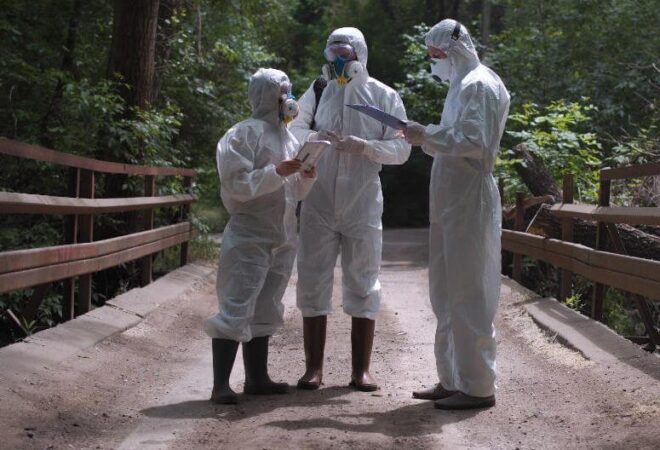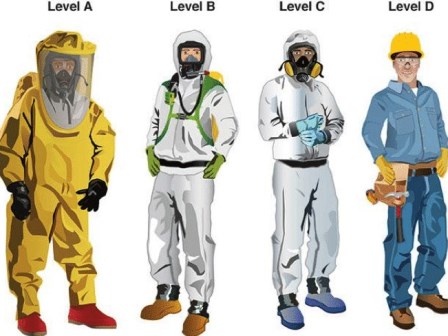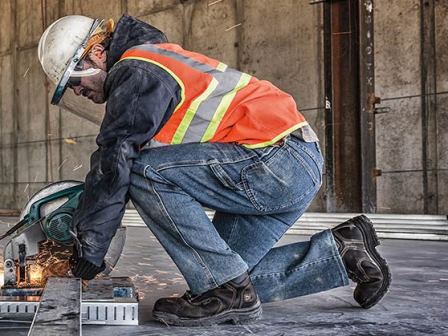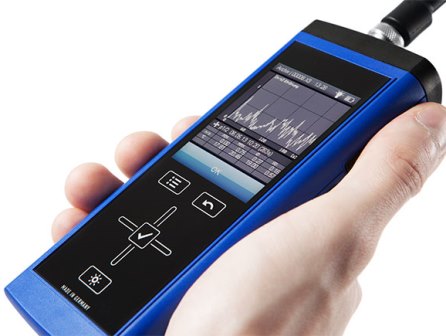Disposable Protective Clothing: Protective clothing is essential to prevent the spray, mist, or dust of pesticides from contacting your skin during an application and also to protect your body from concentrated pesticides during mixing or handling.
Typical protective clothing includes long-sleeved shirts and pants made from a tightly woven cloth fabric (the minimum protection for any type of pesticide handling or application), cloth coveralls, and, for more toxic materials, waterproof rain suits.

Disposable fabrics
Disposable fabrics, manufactured by several companies, are made from non-woven fibers, giving the fabric great strength and resistant to tearing.
Some fabrics are laminated to plastic materials to provide extra protection, certain types of these coated fabrics protect against pesticide penetration.
Various styles and grades of protective clothing made from non-woven fabrics are available. Quality, cost, and the degree of protection vary according to the fabric type, style of the garment, and the manner in which seams and closures are sealed. For use with toxic liquids, the garment must have well-sealed seams and an attached hood.
When selecting disposable protective clothing, choose the right fabric type for protection against the pesticide you will be applying. Disposable protective coveralls suitable for pesticide handling and application are available in three types of fabric.
Disposable protective clothing types
The type of protective clothing used depends on the requirements prescribed by the pesticide label and the type of work being performed.
Disposable protective clothing is a suitable alternative to clothing made from woven fabrics or rubber-coated rain suits.
Disposables have many advantages and, in most cases, provide adequate protection while mixing, loading, or applying pesticides. They are available in a coverall style which may include an attached hood.
Disposables are generally lightweight and loose-fitting, making them comfortable to wear and easy to put on or take off. Disposables are worn over conventional work clothing. Disposability eliminates the need for laundering which can be a problem when dealing with pesticide contamination. Disposable protective clothing is less expensive than non-disposable types of protective clothing.

Tyvek disposable coveralls
The most common example of an uncoated disposable fabric is Tyvek, manufactured by the DuPont Chemical company. Coveralls made from this fabric are lightweight (about 5 ounces) and zip up the front. A pair of coveralls cost between $4.50 and $7 depending on whether it has an attached hood. An uncoated Tyvek suit of this type provides approximately the same degree protection as a pair of coveralls made from tightly woven cotton fabric.
pesticides for which cloth coveralls or long-sleeved shirts and pants would provide adequate protection. It protects against most particulate contamination (dust), but will not prevent skin contact with liquids. Coveralls made from uncoated Tyvek or similar fabrics should not be used for handling liquid pesticides that are moderately or highly toxic.
polyethylene laminated fabric
On-woven fabrics coated with polyethylene provide a greater degree of protection against pesticides since they are waterproof.
This type of fabric is not suitable for extended exposure to liquid organophosphates, however, because solvents in these pesticides damage the polyethylene coating. Examples of organophosphates include parathion, terbufos, diazinon, chlorpyrifos, fonofos, and dimethoate.
Polyethylene-coated coveralls range in price from $8 to $20 depending on the style and method in which seams are sealed prices may also vary by manufacturer. The polyethylene-coating makes the coveralls slightly heavier and stiffer than an uncoated fabric. Also, coveralls made of coated fabric may be more uncomfortable to wear since the fabric does not breathe (see the daytime and nighttime temperature restrictions below.)
saran fabric
saran coated fabric: Saran is another material used as a moisture barrier for non-woven fabrics from which protective clothing is made. Saranex is the trademark for DuPont’s saran-coated Tyvek and is an example of this type of fabric.
Saran-laminated coveralls provide the best protection against pesticides and they can be used effectively with organophosphate liquids. In most instances, coveralls made of saran-coated fabric proved the same amount of protection as rubber or vinyl-coated waterproof rain suits.
These coveralls range in price between $20 and $30, depending on the style, type of seam sealing, and manufacturer. This coated fabric is equivalent in stiffness and weight to polyethylene-coated fabrics and mAy be uncomfortable in hot weather since it does not breathe.
It’s very important to note that neither the P.E. or Polylaminated Tyvek or the Saranex coveralls (or coveralls made from similar fabrics) are suitable for use with chlorinated hydrocarbon pesticides such as methoxychlor.
Reusing disposable protective clothing
Coveralls and other garments made from non-woven fabrics can be reuse, however, they must be laundered between wearing. Follow the guidelines for laundering other pesticide-contaminated clothing or consult the manufacturer for instructions.
This protective clothing should be disposed of if the laminated coating is torn or begins to separate from the fabric or if seams or closures are not properly sealed. Never launder or reuse disposable coveralls or any other type of protective clothing that has been heavily contaminated with an undiluted pesticide.
With heavy contamination, it may not be possible to remove all traces of pesticides through any type of laundering.
The coveralls are protective clothing, which protects the workers and their clothing from having direct contact. These coveralls come in various types and each type serves in a unique way to serve a complete safety and protection to the workers. Due to this protective quality, these safety coveralls are highly in demand.

What are coveralls used for?
Coveralls are one-piece, loose-fitting protective suits that offer protection against outside contaminants over a large area of the body. Coveralls are generally worn over the top of personal clothing and can protect workers against a number of hazards such as chemical, mechanical, thermal, and biological nature.
Protective coveralls were created to ensure a high level of protection during work activities. They cover or replace personal clothing and their main purpose is to protect the worker from chemical, biological, mechanical, thermal, electromagnetic, and electrical hazards.

Protective Clothing
Protective clothing is clothing designed to protect either the wearer’s body or other items of clothing from hazards such as heat, chemicals, and infection.

Best Construction Clothing Brands
When work becomes monotonous, construction equipment brands create and design casual clothing for fans of these brands.

Industrial Digital Thermometer
They are generally more durable than laboratory thermometers. Operation depends on the type of temperature sensor you use.
